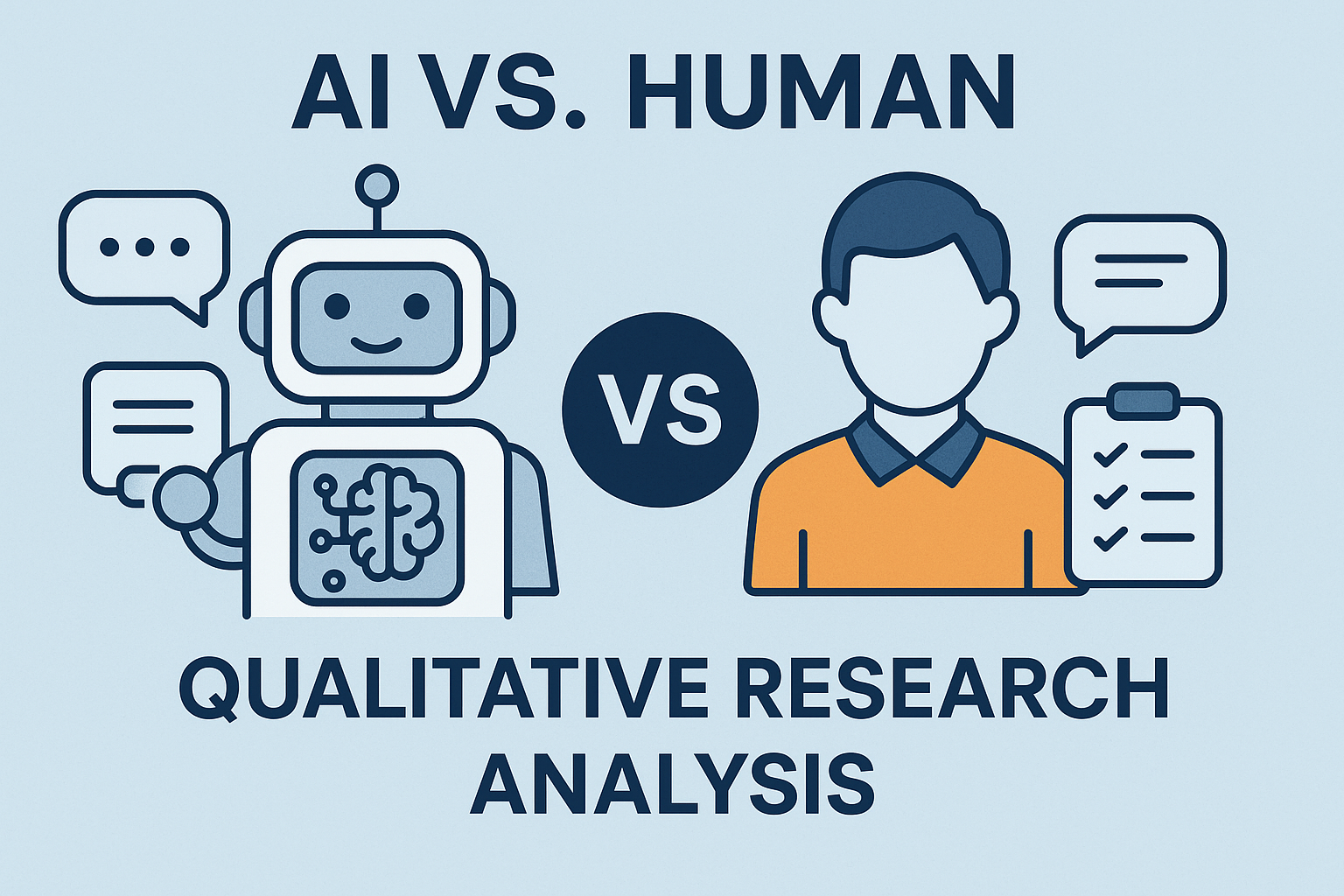The Evolution of Qualitative Analysis
Qualitative research—user interviews, open-ended surveys, focus groups—is rich with insights that help teams understand the "why" behind human behavior. But the analysis process? Traditionally slow, labor-intensive, and overwhelming.
Enter AI. With tools like Reveal, and others, UX researchers, product managers, and market researchers are tapping into AI's ability to transcribe, organize, and even synthesize insights from large volumes of qualitative data.
In this post, we’ll compare human-led versus AI-assisted analysis, explore where AI shines (and where it stumbles), and share practical tips on how to blend both for a powerful, streamlined workflow.
The Human Way: Deep, Contextual, but Slow
Human-led qualitative analysis typically follows this path:
- Transcribe interviews (manually or with tools).
- Read and re-read to become immersed in the data.
- Code text into themes—usually dozens or hundreds.
- Group codes into broader themes.
- Interpret and synthesize insights.
- Report findings with quotes, context, and strategy.
This process delivers deep, nuanced understanding. It’s ideal for sensitive topics, small sample sizes, and projects requiring rich context. But it’s slow, hard to scale, and inconsistent across researchers.
How AI Tools Analyze Qualitative Data
Modern AI tools can:
- Transcribe audio/video at scale.
- Summarize sessions (notes, highlights).
- Auto-code and cluster recurring themes.
- Enable semantic search across transcripts.
- Compare cohorts or surface contradictions.
- Extract clips
- Draft insight summaries and reports.
Example: Reveal generates codebooks, groups quotes by theme, and ties each insight to exact sources for traceability.
Human vs AI: Strengths and Tradeoffs

When to Use AI (and When to Go Human)
Use AI when:
- You’re short on time or overwhelmed by volume.
- You want a first-pass synthesis.
- You need to compare responses across cohorts.
- You’re analyzing survey open-text at scale.
Lean on human analysis when:
- Topics are emotionally nuanced or sensitive.
- Context and domain knowledge are critical.
- You’re working with a small, high-stakes sample.
- You need deep stakeholder engagement in synthesis.
Best Practices: Getting the Most from AI
-
Treat AI as an assistant, not a replacement. Always validate outputs.
-
Be specific in prompts and structure your data well. Garbage in = garbage out.
-
Use traceable tools. Tools like Reveal link every AI finding to original quotes.
-
Iterate. Don’t settle for the first AI output. Refine it.
-
Protect privacy. Anonymize sensitive data.
- Check for gaps. AI often misses what’s not said—humans catch those silences.
How AI Fits into Your Workflow
1. Planning and Design:
- Use AI (e.g., ChatGPT) to brainstorm interview questions, refine discussion guides, or simulate potential participant responses.
- AI can help identify potential research gaps or suggest hypotheses based on prior data.
2. Data Collection:
- Deploy AI-powered tools like Otter or Grain to record and transcribe live sessions.
- Use real-time AI-generated summaries to share initial impressions immediately with stakeholders.
3. Data Preparation:
- Let AI handle transcription, translation, and redaction of sensitive information.
- Use automated formatting or tagging tools to prepare data for analysis.
4. Coding and Analysis:
- Use AI to generate a first-pass codebook or cluster quotes into emerging themes.
- Search transcripts semantically using AI to uncover non-obvious connections.
- Use tools like Reveal to visualize theme distribution and compare participant cohorts.
5. Insight Synthesis:
- Ask AI to summarize each theme and highlight illustrative quotes.
- Use AI to explore contradictory feedback or triangulate across data sources.
- Draft insight statements, hypotheses, or user stories from synthesized themes.
6. Reporting and Delivery:
- Generate AI-assisted reports or executive summaries.
- Create slide decks, visualizations, or video clips highlighting user sentiment.
- Use AI to tailor findings to different stakeholder personas.
7. Post-Delivery Q&A:
- Keep AI tools handy to answer follow-up questions like “Did users mention feature X?” or “How do older users compare to younger users on this point?”
- Quickly re-query data for new themes or emergent trends post-launch.
In each phase, the human researcher remains in control—interpreting, validating, and telling the story. But AI removes the friction, accelerates time-to-insight, and makes analysis more scalable than ever before.
It’s Not Human vs AI. It’s Human + AI
AI won't replace researchers—it’ll supercharge them. Let machines do the heavy lifting, so you can focus on asking better questions, interpreting results with empathy, and driving action.
AI transforms qualitative analysis from a bottleneck into a springboard. But only when paired with human judgment.
So, the next time you're facing 20 hours of interview transcripts? Let AI take the first pass. You bring the insight.

